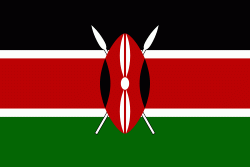Webuye
Webuye, previously named Broderick Falls, is an industrial town in Bungoma County, Kenya. Located on the main road to Uganda, the town is home to the Pan African Paper Mills, the largest paper factory in the region, as well as a number of heavy-chemical and sugar manufacturers. The area is heavily populated and is used mainly for subsistence agriculture. The area around Webuye is home to the Bukusu and Tachoni tribes. The town has an urban population of 19,600 (1999 census) and 22,507 in total according to the GeoNames geographical database.
Villages near Webuye include Lugulu, Milo, Maraka and Misikhu. Webuye is home to the Broderick Falls of Nzoia River. In Maraka, there exists the famed "mfunje" suspension bridge which consists of rickety timber strips joined together with some metal wires, precariously dangling across River Nzoia. It attracts a considerable number of both local and foreign tourists who enjoy the thrill of crossing the river on the shaky locally-made bridge.
Webuye has in the recent past also seen the establishment of some important education centres, including a constituent college campus of the Masinde Muliro University of Science and Technology, and a Kenya Medical Training college Campus. The town's economy was hit hard by the dwindling fortunes of Pan African Paper Mills, which was closed down in 2008. Efforts have been put in place by successive regimes since then to reopen the paper mill, but without success. The nearest tourist attraction is the Nabuyole waterfalls on River Nzoia. The falls are seven kilometres from Webuye and provide a cool breeze to tourists.
In the pre-independence times, Webuye was known as Broderick Falls, after the first white man to visit the nearby Nabuyole falls on River Nzoia. Today, it's named after a cobbler who repaired shoes for railway workers.
Villages near Webuye include Lugulu, Milo, Maraka and Misikhu. Webuye is home to the Broderick Falls of Nzoia River. In Maraka, there exists the famed "mfunje" suspension bridge which consists of rickety timber strips joined together with some metal wires, precariously dangling across River Nzoia. It attracts a considerable number of both local and foreign tourists who enjoy the thrill of crossing the river on the shaky locally-made bridge.
Webuye has in the recent past also seen the establishment of some important education centres, including a constituent college campus of the Masinde Muliro University of Science and Technology, and a Kenya Medical Training college Campus. The town's economy was hit hard by the dwindling fortunes of Pan African Paper Mills, which was closed down in 2008. Efforts have been put in place by successive regimes since then to reopen the paper mill, but without success. The nearest tourist attraction is the Nabuyole waterfalls on River Nzoia. The falls are seven kilometres from Webuye and provide a cool breeze to tourists.
In the pre-independence times, Webuye was known as Broderick Falls, after the first white man to visit the nearby Nabuyole falls on River Nzoia. Today, it's named after a cobbler who repaired shoes for railway workers.
Map - Webuye
Map
Country - Kenya
 |
 |
| Flag of Kenya | |
Kenya's earliest inhabitants were hunter-gatherers, like the present-day Hadza people. According to archaeological dating of associated artifacts and skeletal material, Cushitic speakers first settled in Kenya's lowlands between 3,200 and 1,300 BC, a phase known as the Lowland Savanna Pastoral Neolithic. Nilotic-speaking pastoralists (ancestral to Kenya's Nilotic speakers) began migrating from present-day South Sudan into Kenya around 500 BC. Bantu people settled at the coast and the interior between 250 BC and 500 AD. European contact began in 1500 AD with the Portuguese Empire, and effective colonisation of Kenya began in the 19th century during the European exploration of the interior. Modern-day Kenya emerged from a protectorate established by the British Empire in 1895 and the subsequent Kenya Colony, which began in 1920. Numerous disputes between the UK and the colony led to the Mau Mau revolution, which began in 1952, and the declaration of independence in 1963. After independence, Kenya remained a member of the Commonwealth of Nations. The current constitution was adopted in 2010 and replaced the 1963 independence constitution.
Currency / Language
| ISO | Currency | Symbol | Significant figures |
|---|---|---|---|
| KES | Kenyan shilling | Sh | 2 |
| ISO | Language |
|---|---|
| EN | English language |
| SW | Swahili language |















